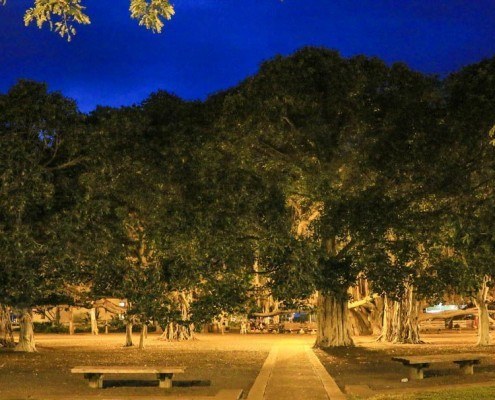
What To Expect November Thru February on Maui
Winter is an amazing time to visit Maui. The humpback whales are visiting our warm waters, the weather is better than anywhere else in the United States and there are plenty of things to do. We share in some of our other posts details about the major events of the season, including what to do in Maui during Christmas and New Years!
Get some insight about Maui and what winter means here
ANCIENT HAWAIʻI AND THE SEASONS
The ancient Hawaiians described 2 basic seasons each lasting approximately 6 months. The winter months are known as Ho’oilo in Hawaiian which means the “wet & cooler” season. The hot and drier months were called Kau, or the summer months. Variations on these words differ from island to island but ancient Hawaiians from all the islands were masters at observing and sustaining a beautiful and wise connection with nature.
The months were based on the position of the stars and the names of the months again varied from district to district and island to island. The arrival of the Kohola (humpback whale) and the rising of the constellation Peleides at sunrise signaled the beginning of the wet season to Maui’s ancient people.
The wet season (wintertime running from November to March) also marked the beginning of an approximately 4 month long season of agriculture and celebrations called “Makahiki”. This was the season of the creator god Lono and war was forbidden so the populace could farm. Other kapu (restrictions) included a ban on deep sea fishing in the rough and stormy winter ocean. Imagine the replenishment of the fish stocks that occurred with a four month break every year in fishing of such species as Ahi (tuna) Mahimahi and Marlin!
The Ho’oilo (wet & cooler) season of Makahiki was a time of planting sweet potato, banana and taro. Much ceremony was given to the first plantings signaled to begin by the priests who observed the Pleiades constellation rising above the horizon at sunset. Four months or so later the Makahiki season concluded with the arrival of the chief Ali’i and/or his representatives to collect harvest tributes. This also signaled a celebration of song, hula, games, ceremonies and feasting.
Naming The Months
Ancient Hawaiians had names for each month of the year but again these names can vary from island to island. They were named to coincide with the stars and signified which fish were either in season for catching or off limits (kapu) as they spawned.
Welehu (Oct – Nov) Rainy season. Beginning of Makahiki, a four month long harvest festival. Opelu and Akule fishing.
Makali”i (Nov-Dec) The stars were observed as being in the winter solstice. Land was prepared for planting. Opelu and akule were fished but the ‘ama’ama (Mullet) were spawning through February and so a Kapu (restriction) was placed on fishing for them.
Ka’elo (Dec Jan) Uala (sweet potato) planting in the dry leeward sides of the island took advantage of the winter Kona storms coming in from the south. Reef fishing also was good during this time.
Kaulua (Jan.-Feb.)–Ke Ali’i o Kona i ka Lewa (Canopus constellation) in the SE evening sky. In traditional times, aku kapu lifted at the end of Makahiki; ‘opelu kapu through July during its spawning season; reef and inshore fishing. A second round of planting starts for appropriate areas.
Nana (Feb.-Mar.)–Sun rises due east and sets due west (spring equinox). Mulch and weed gardens; vigorous plant growth begins. ‘Ama’ama fishing season opens; malolo (flying fish) spawning.
MAUI’S WINTER WEATHER
It’s actually quite difficult to describe the weather on Maui during the winter because it has so many climate zones. The weather on Maui is quite different depending on where you’re at on any given day. The south side areas of Kihei and Wailea is a leeward “dry side” of the island and known for miles of incredibly beautiful beaches. The west side areas of Lahaina and Kaanapali are also fairly dry with rain increasing the farther you head towards Napili and Kapalua.
What to Expect During The Winter On Maui
The winter months in Maui (November thru February) are a bit cooler. Temperatures range from mid 70’s to low 80’s during the day and mid 60’s at night. The higher elevations along the slopes of Haleakala can be quite chilly in the mornings (mid 40’s and 50’s) but always warm up during the day to the 70’s. We do get what’s called “Kona Storms” that roll in from the southeast. They bring warm steady rains to the leeward (drier) areas of the island.
Storms to the north also bring in winter swells which make for spectacular waves along the east and north facing coastlines. Some of these are big enough to wrap around the island bringing surf to the normally quiet south shores. Rain can also approach the island from the north, usually carried by the trade winds which can reach upwards of 15 to 20 mph with gusts to 35mph. This is one of the reasons Maui is known as the “Windsurfing capital of the world”. The combination of strong winds and big waves makes for an exciting winter on the north shore!
Here on Maui we even get snow… It adds beautifully to the holiday season but is rare and always fleeting. Hawaiians have known of snow in ancient times as they have a name for it – Haunani, which means “beautiful snow”. Hawaiian mythology also describes one of four snow goddess, with Poliʻahu on the Big Island being the most powerful. Legends say she often fought with her enemy Pele, the volcano goddess.
One of the first long term western residents of the Big Island is John Young who arrived in 1790. He was quoted by James Macrae in 1825: “During the 26 years Mr Young has lived here (Kona) he has never seen Mauna Kea free from snow”.
There are also historical records of snow on the island of Molokaʻi in 1912. It was the only known occurrence of this kind of weather on Molokaʻi since modern record keeping began in the early 1800’s. Weather in the Hawaiian Islands may feel like a tropical climate but it is actually on the edge of a sub-tropical zone. This is why we have cooler winters and ideal temperatures year around not always found in the hot and humid southern polynesian islands.
Road to Hana Weather
The waterfalls along the Hana highway can be at flood stage during our winter weather so be careful…flash flooding is a real danger in this area.
If you’re on a Hana van tour this won’t be a problem as they monitor the conditions on a daily basis so you’ll be assured of what’s happening out on this side of the island. It can be a gorgeous sunny day in Kihei or Lahaina and be full on storming in Hana. It’s best to go with the experts who will keep you safe and show you the best of this incredible scenic drive.
Maui’s Many Micro-Climates
Our island has many microclimates and Haleakala has the largest diversity of these climates because of this mountains 10,000 ft elevation. Snow can appear on the summit of Haleakala usually between November and February as well as on the Big Island’s volcano summit of Mauna Kea, which rises to over 13,000′ elevation. Mauna Kea means “White Mountain” as it’s peak can stay covered in white for weeks at a time. Locals actually ski and snowboard on the volcano slopes on the Big Island. It’s a rough ride as the lava rock is sharp and the lift consist of a 4 wheel drive pickup truck!
The last few summers have seen some of the hottest and wettest conditions on record. Usually the dry months of June thru October leave the island slopes with a warm tan. This year (2020) they are already a deep green and the grasses and foliage along the roads are already high and deep. With the winter rains this year it should be a spectacular time to visit Maui as it is green and lush even on the normally dry sides of the island.
Another signal to the winter months is the vegetation. For example the poinsettia start to turn a bright red and since they grow year around in Maui you may see hedges of these colorful plants as high as 8 feet or more!
THINGS TO DO AND TIPS FOR YOUR MAUI VISIT THIS WINTER
Bring some rain gear
Umbrellas don’t work that well in Maui because they get launched by the wind. It’s best to bring a light rain jacket or windbreaker for venturing out on rainy days. Keep in mind that it may be raining where you are but not necessarily where you’re headed. Check the local weather forecast on the evening news or online at sights like Maui Now. Also webcam sites can give you real time info…
If you’re going to Haleakala Crater
Bring that same jacket. Also wear some pants and shoes. In the winter months Haleakala’s 10,000 foot summit is cold…cold enough for snow with winds that can reach speeds of 50 to 70 miles per hour!
Whale Watching
There are some wonderful things to do during the winter months and the biggest is definitely whale watching. There are many boat tours all around the island offering whale watching so be sure to jump on board. The whales can also be seen from shoreline too!
Check out boats like the Pride of Maui, Redline Rafting or take a self-powered option using a kayak or canoe.
Big Winter Surf
Another wonderful thing to do in the wintertime in Maui is go check out the big surf.
The north shore areas of Kanaha and Paʻia in the winter have the most spectacular big waves and wind from the storms in the north pacific (which become North American weather systems). These weather systems produce our big swells in the winter months. East Maui (the Hana side) catches these big swells along the road to Hana including trade wind showers which produce rain throughout the year. This is why the ancient Hawaiians had over 200 names for rain! It’s also the reason there’s such an amazing and ancient rainforest on this side of the island.
Traffic
When it rains (as in the case of a Kona storm) the traffic slows to a crawl. Be sure to leave 30 to 40 minutes early to get where you’re going if it is storming. Also if you’ve booked activities in advance for things like tours be sure to check in with them and make sure it has not been canceled or delayed due to weather.
The road to Hana is another drive that can be a challenge even on a sunny day much less on a rainy one. It’s best to book a tour because they monitor this roads weather daily and know the conditions ahead of time. A tour will also give you much in the way of local knowledge about Maui from the tour guide.
Cancelled tours
All tour companies are happy to reschedule you if your tour date is canceled due to weather. However if you decide to cancel yourself in favor of trying to catch a better day weather-wise for your tour keep in mind most tour companies need 24 to 48 hour advance notice for a refund or reschedule.
So there you have it. (If you are looking for more ideas, check out this list.) Maui is an amazing place year around but there is something special about the winter months. The sun sets on the ocean farther to the east making for some spectacular views from the south shore. The whales add an exciting presence as they splash around near shore. It truly is a magical time to be in Maui!
Aloha Nui Loa








